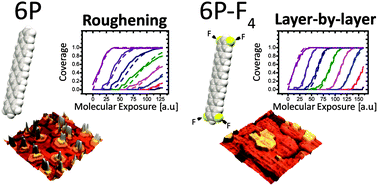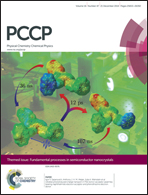Controlling the growth mode of para-sexiphenyl (6P) on ZnO by partial fluorination†
Abstract
We report on the impact of partial fluorination of para-sexiphenyl (6P) on the growth mode when deposited on the non-polar ZnO(10![[1 with combining macron]](https://www.rsc.org/images/entities/char_0031_0304.gif) 0) surface. The evolution of the thin film structure and morphology is monitored by in situ atomic force microscopy and in situ real-time X-ray scattering. Both 6P and its symmetrical, terminally fluorinated derivative (6P-F4) grow in a highly crystalline mode, however, with a distinctly different morphology. While 6P films are characterised by the formation of two different phases with three-dimensional nanocrystallites and consequently a rather rough surface morphology, layer-by-layer growth and phase purity in case of 6P-F4 prevails leading to smooth terraced thin films. We relate the different growth behaviour to specifics of the thin film structure.
0) surface. The evolution of the thin film structure and morphology is monitored by in situ atomic force microscopy and in situ real-time X-ray scattering. Both 6P and its symmetrical, terminally fluorinated derivative (6P-F4) grow in a highly crystalline mode, however, with a distinctly different morphology. While 6P films are characterised by the formation of two different phases with three-dimensional nanocrystallites and consequently a rather rough surface morphology, layer-by-layer growth and phase purity in case of 6P-F4 prevails leading to smooth terraced thin films. We relate the different growth behaviour to specifics of the thin film structure.


 Please wait while we load your content...
Please wait while we load your content...